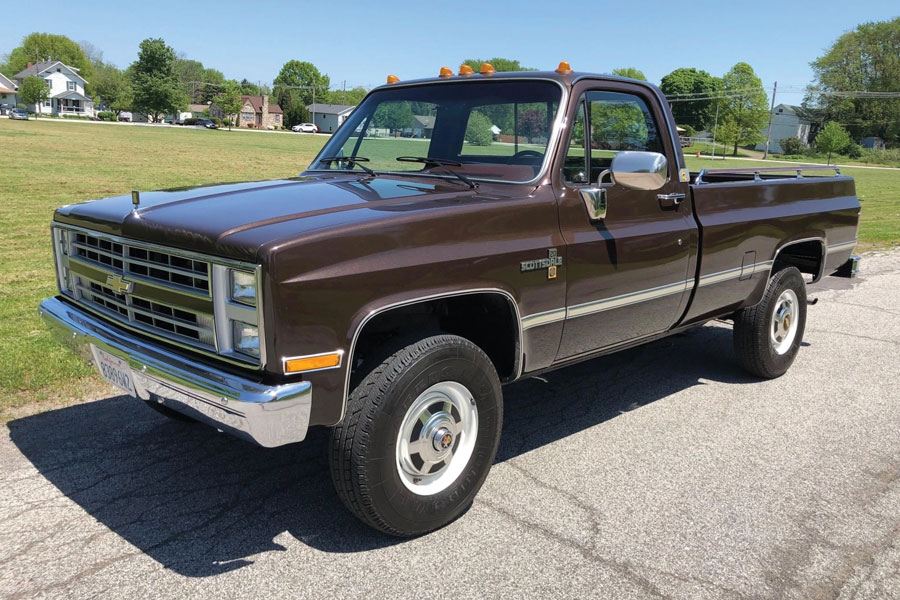There’s a moment in time when mundane cars become something more. I’m fascinated by that moment, because the turning point of interest is the absolute cutting edge of the classic-car market. It’s where new trends are born.
If you want to understand where we’re going as a market, you have to really look at where we are right now — specifically when it comes to buyers’ extensions from the norm. Sorting through pricing outliers can teach us a few things about the future.
Here’s a concrete example: On June 22, Bring a Trailer wrapped up an auction on lot 32978 — a 1985 Chevrolet ¾-ton pickup. At first glance, it was not all that special. Brown. 350. Four-speed truck transmission. Four-wheel drive. It didn’t have a/c or even the higher Silverado trim. But what it did have was just 589 miles and all its original paperwork, which led to a still-can’t-believe-it price of $88,725.
Crazy, right? This truck is fundamentally no different than the one I see hauling yard tools into my neighborhood every Tuesday. Yet here we are, talking about it in SCM — the home of million-dollar Ferraris and Bentleys.
Does the truck really belong? You might say no, but I think it does, even if only because it’s instructive.
Climbing the grade
I know that one sale does not make a market. But while this work-truck-turned-collectible brought a new record price, I wasn’t surprised by it, or by the number of emails and conversations I had about it after the fact. Some folks had a hard time accepting the price; others just wanted to know what it meant.
Older American trucks have been valuable for quite some time. We covered the rise of later-model trucks in American Car Collector magazine over a year ago, and interest has continued along despite today’s coronavirus-related limitations.
Combing through auction sales from 2019 through today will show you more than a few 1970s and 1980s American pickups sold at well above what you might consider reasonable pricing. Sometimes, like with Big Brown here, prices really ring the bell due to something like super-low miles — especially when those sales are outside farm country. But while expensive, this isn’t the outlier you might think it is.
Rolling through the past five years of data will bring you to one conclusion: Americans love pickups, and they’re willing to pay up for the best classic examples. That hasn’t changed.
We — the buying pool — is what’s changing, along with our definition of “classic.”
Signal in the noise
In previous SCMs, Miles Collier has referenced the need to separate the signal from the noise as it pertains to the classic-car market. Which sales are true trends and which are anomalies? Was this truck sold to a seasoned collector making a careful decision, or was this some wackadoo new-money millionaire burning cash to excite a Monday?
For my purposes here, it doesn’t really matter. When it comes to a market waking up to a new model or genre, I figure the noise is the signal.
I’m not going to argue that this ultra-low-miles rig was worth the money spent here. But justified or not, sales that create buzz have a way of changing how we, as collectors, look at a model.
It’s especially true when the buzz repeats itself, clarifying into a clearer signal. We have seen solid pricing on a number of later-model trucks over the past year or so — both stock and modified.
Even if you’re not a truck person, I bet you’ll see a yard guy’s ’86 C20 a little differently now, even if it’s just to remind you of this crazy sale. The point is, you’ll notice, and the first thing you’ll find when you actually start looking is that while they were once everywhere, a lot of these trucks are now gone.
That realization is the first step in building nostalgia in some of us, and once our nostalgia takes hold of something, watch out. Pricing follows.
You can apply this to any number of lesser-grade collector cars, from Japanese econoboxes to once-cheap British sports cars. For cars and trucks that weren’t born special — stuff that earned its reverence by being part of people’s lives until used up and discarded — this is how pricing outliers can lead to a new market trend.
So should you run right out and buy a 1970s or 1980s American truck? That depends on you. I’ve always said that car people should have trucks, too — but if you don’t connect with this part of the American experience, a brown K20 isn’t going to charm you.
But if, when you look at this truck, you see crisper lines than you remember, more metalflake than you thought they had, or are relieved by the last era of mechanical simplicity before ghosts in the machine became the norm, you might be smart to start looking for one now.
They’ll be more expensive tomorrow. ♦

